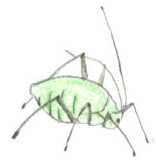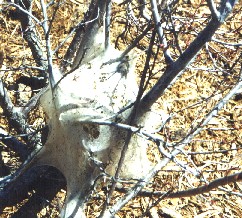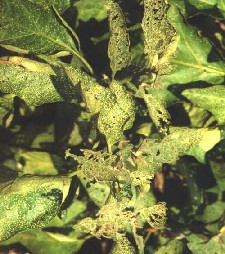- Aphid
- Eastern Tent Caterpillar
- Flea Beetles
- Japanese Beetles
- Pill Bugs
- Cutworms, Squash Borers and Squash Bugs
- Cucumber Beetles
Animal Pests
Important information about pesticide use
A lot of us have a tendency to view bugs as
"good" or "bad." The good bugs don't eat our plants, and the bad
ones do...or the bad ones are the ones we fear for whatever reason. Understanding
the role they play in the balance of nature that goes on in our back yard is important to
understand the connection between insects, the garden, and us.
Excessive use of chemicals in the garden can
very easily disrupt the delicate balance of insect and animal life in your garden, since
pesticides often eliminate the "good bugs" with the "bad."
Excessive and unnecessary use of pesticides can also produce resistant strains that can
overpopulate in a very short time. Unnecessary use of pesticides can also
reduce populations of frogs, lizards, and snakes, which feed on the larger bugs such as
grasshoppers, beetles, and roaches. Snakes also keep insects, mice and rabbit
populations down as well.
In preserving this balance, and realizing that
many of the plants we grow attract beneficial insects and animals to our yard, we need to
be careful that we don't contaminate this life with pesticide overuse.
All this, and I haven't
even mentioned the health risks and hazards to human beings!
On the other hand, common sense will tell us that there may come a time when we may need to use a pesticide because of a pest situation that is very much out of control. So use your own judgment with pesticides; use them carefully and cautiously, keeping in mind that, with a few exceptions, there are many alternative solutions to using chemicals that can help to maintain the balance of wildlife in your area without harm to living things.
For the homeowner, good gardening practices and careful attention to your plants are among the best ways of controlling pests and disease. I will do my best to mention as many organic solutions as possible, and also let me know what natural controls work for you!
APHIDS (Homoptera)
 Aphids are soft-bodied insects just under
1/10" in length, that feed on plant juices and can transmit disease in
plants. They come in different colors, and appear in large numbers in the
spring. They excrete honeydew that attract ants, that in turn, protect the aphids
from predators.
Aphids are soft-bodied insects just under
1/10" in length, that feed on plant juices and can transmit disease in
plants. They come in different colors, and appear in large numbers in the
spring. They excrete honeydew that attract ants, that in turn, protect the aphids
from predators.
Aphids may or may not have wings and may be green or brown. This is an insect that is built for survival. Eggs that hatch in spring produce mostly female aphids. These first generation females feed in masses on plants, and can give birth to live young without a male. Then later in the season, new generations mate and produce eggs in fall, which will hatch the following spring.
CONTROL
Aphids appear in large numbers
on tender new growth in the early spring, after several weeks of warm weather.
Although the aphid has many predators, these predator insects haven't yet developed
in numbers large enough to control aphid populations at this early point in spring.
Many people, when they see
aphids on their plants, think "BAD BUG," and get out the
pesticides. Keep in mind that lots of bugs eat aphids. They are
soft-bodied and make juicy treats for other insects (Yum). If ladybug larvae are
present on the plant, they will be destroyed along with the aphids if sprayed... ladybug
larvae are small, and can eat aphids rapidly and in large numbers. Lacewing
moths and their larvae also devour aphids. There is a way, in most cases, to easily
control aphid populations (until the beneficial insects arrive several weeks later)
without the use of chemicals. This is how it's done:
When watering your plants, spray water on the leaves of the aphid-infested plants, using slight pressure in spraying (be careful not to injure the plant). The purpose is to hose off the aphids. Do this early in the morning or later in the day, when the sun isn't shining directly on the leaves. Then repeat this procedure every two or three days. This will reduce the population and minimize plant damage until the predators come. If predators are washed off, they won't be harmed. The aphids, however, take a long time to find the plant again, and once on the ground are more likely to be eaten before they can recover their bearings.
You may also choose to do nothing, and wait
for the predators to find the aphids....however, there is a possibility of plant damage in
the meantime.
Also, a ladybug's favorite dinner is aphid, so
if you happen to find one while working in the garden, place it on a plant that has aphids
on it, and let it go to work. Also, learn to recognize the larval stage of the
ladybug. Many people mistake it for a bad bug, because of it's somewhat vicious
appearance. The only thing vicious about it, is the way it devours aphids, at an
even faster rate than the adult ladybug. You can attract ladybugs and other
beneficials to your garden by planting companion plants that they like. Such plants
include cilantro, parsley, fennel, (carrot family plants). These plants have small
flowers that are a rich source of nectar for the predator larvae. Grow these
near your aphid-prone plants and it should tip the scales in your favor.
Look for this brown, fuzzy worm crawling around in the
spring, crossing driveways and sidewalks. (They're everywhere, they're everywhere!)
Once mature, the worm pupates, then becomes a moth that lays eggs which hatch new
caterpillars. The caterpillars create a silken tentlike structure in the crevices of
tree branches. During the day the larvae feed on leaves, and return to the
"nest" at night.

Actually, by the time you see two-inch worms crawling across your driveway, they are
looking for a place to pupate, and although seen on bushes and shrubs at that time, have
reached their mature size and will no longer feed. I have even seen masses of their
white coccoons in lawn grasses! Once the larvae hatch, they seek out trees and
shrubs and form their silken tents. Their favorite hosts are wild cherry, apple, and
crabapple trees, but can be found on other fruit trees and maples and other trees as well.
Damage from these pests can result in defoliation of trees,
if the population is high enough. Most trees recover from damage, but the stress on the
tree can encourage other problems. There are several non-chemical solutions.
If the tree is mature enough, the branches containing the web can be pruned out (in late
afternoon or early evening) and dispose of the nest. Check and dispose of egg masses
on tree branches in early spring.
The nest can be opened and torn apart with a stick or other object, exposing the worms to
birds, wasps, and other predators. You can also blast the worms out of the open nest
with water forcefully sprayed from a hose, or better, spray the opened nest with a
solution of BT (Baccillus Thuringiensis--var. kurstaki), a biological control for worms.
An option for the not-so-squeamish, is hand-picking. If this is too gross for
you, invite a child to go on "bug patrol," armed with a bucket of soapy water to
drop them in, or they may find pleasure using the stomp and squish method. The
latter is rather disgusting on driveways. I handpick mine and feed some of them to
the bullfrog that sits in my pond. Man's best friend may just be a frog...try
getting a dog to eat a caterpillar!
For more information: http://muextension.missouri.edu/xplor/agguides/pests/g07271.htm
 As
you can tell by the picture (left), flea beetles can do extensive damage
to many crops, as seen on this eggplant. Flea beetles are tiny
little beetles, that hop when you touch them, much like a
flea. They chew little holes all over the foliage, and left
unchecked, can cause crop failure. Flea Beetles are most active in
hot weather conditions, and seem to disappear once the weather turns cool.
As
you can tell by the picture (left), flea beetles can do extensive damage
to many crops, as seen on this eggplant. Flea beetles are tiny
little beetles, that hop when you touch them, much like a
flea. They chew little holes all over the foliage, and left
unchecked, can cause crop failure. Flea Beetles are most active in
hot weather conditions, and seem to disappear once the weather turns cool.
CONTROL
A natural way to control flea beetles, is to start early, while the plants
are still small, sprinkling Diotomaceous Earth (DE) to the leaves.
As the name implies, Diotomaceous earth consists of tiny little diatoms
from the ocean, that have been dehydrated into a powder. It is
available in many garden centers, or co-ops, is relatively
inexpensive. This powder feels like powder to the human hand, but to
soft-bodied insects (like slugs) it is razor sharp. For the
flea beetle, DE acts as a barrier between the leaf and the bug.
Imagine how appetizing would your salad be, if you sprinkled powder on the
leaves?? White flour will also work...however, it may excessively
clog the pores of the leaves. The most important thing with using
this control, is that you are vigilant about re-applying it after it
rains.
JAPANESE
BEETLES
CONTROL:
Handpick at first sign, flick them in soapy water.
Be diligent!
In the meantime you can "milky spore" which is effective against the grubs.
Do not use lures; they will just
attract more! I'm still doing research on what to do about mass
quantities on trees and hard to reach areas.
Japanese Beetle feeding on rose blossom
PILL
BUGS
Pill bugs (and Roly-Poly’s)
like moist areas and feed on decomposing material AND PLANTS.
CONTROL:
Place some boards and they will hide under there.
Then rake them up.
Loosely roll up a damp newspaper and tie it with
string, placing it where bugs camp. During
the night, they crawl inside, then dispose of them and the newspaper.
Repeat until they are under control.
CUT
WORMS, SQUASH BORERS, AND SQUASH BUG CONTROL
Cut Worms:
Cut a toilet paper tube in half, and slip the tube over the
top of the young plant. Bury it
an inch or more from the soil surface.
Squash Borers:
Use aluminum foil around the base of the plant.
Squash Bugs:
Plant Borage near curcurbits, especially zucchini…THIS REALLY
WORKS!
Cucumber
beetles look like green ladybugs. They
eat the leaves and flowers of curcurbits such as cucumbers and squash
plants, and are attracted to the yellow and orange color of the flowers.
They transmit a bacterial wilt which can cause the entire plant to
wilt and die within a few days.
Those cute little bunnies you see in the springtime can really wreak havoc on your garden plants. They are looking for the tender green shoots that you have been waiting to appear after a long winter. You wake up one morning, and find breakfast leftovers of green leaf tips and stems laying on the ground. Your plant is whittled to a stub. Here are some ideas you can try to keep rabbits from harming your plants.
Unfortunately, experience will tell you which plants the rabbits favor. The rabbits in one neighborhood may really like asters, while rabbits in another area may leave asters alone and clip on clematis stems. Watch for areas of tall grass, where rabbits like to nest and raise their young. If you have a roaming cat, they help with the rabbit population.
CONTROL
Rabbits have a keen sense of smell. They tend to stay away from
pungent scented leaves, such as sage, onion/garlic, mints, and lamb's ears.
You can plant these kind of things in the area where rabbits like to feed.
They also don't like anything that smells like a predator, so you can use
unwashed dog clippings around your plants, or sprinkle blood meal around and
under the plants. I have used crushed raw garlic under and on shrubs
that rabbits like to hide in, with excellent results! Pepper sprays
work on rabbits, and don't harm plants. These products will need to be
reapplied after rains. You might consider it
for a small garden, or for a few target plants. With the size of my
garden, I can easily go through three bottles in the spring. At
approximately 12 to 13 dollars a bottle, this is too costly to be an option
for me. Dog clippings, however, are free, and rain just makes it smellier!
 Another thing I've tried that also annoys birds
and rabbits is to use a
CD on a string suspended from a plant support. The light reflecting on the CD scares
away critters as it twirls with the slightest breeze.
Another thing I've tried that also annoys birds
and rabbits is to use a
CD on a string suspended from a plant support. The light reflecting on the CD scares
away critters as it twirls with the slightest breeze.
BEST: If you just want to keep rabbits away with the least amount of effort, a fence of chicken wire works very nicely. I use green chicken wire fencing, because it is hard to see, not shiny and conspicuous like the metal fencing. Otherwise, you can easily make little cylinders out of green chicken wire to place around small individual plants that you want to protect, until the plant is bigger, and the leaves toughen a bit. The cages can then be removed by early to mid summer.
Deer can be a serious problem in areas where there are no natural predators, such as your own back yard! The damage by scraping and browsing can be substantial. Here is a list of plants not favored by deer.*
Trees:
Ash, Birch, Cedar, Cypress, Gingko, Ironwood, Locust (black), Mimosa, Sassafras, Sweet Gum, Sycamore, Tulip tree, Beech, Catalpa, Chestnut, Dawn Redwood, Hemlock, Larch, Honey Locust, Redbud, Sourwood, Spruce, Tree Lilac, Russian Olive, American Holly
Groundcovers
Ajuga, Bergenia, Catmint, Ferns, Indian strawberry, Lady's Mantle, Lily-of-the-Valley, Lungwort, Pachysandra, Sedum, Snow-in-Summer, Vince, Wild strawberry, Barren strawberry, Bunchberry, Epimedium, Ginger, Juniper, Lamium, Lily turf, Mosses, Potentilla, Sempervivum, Sweet Woodruff, Violet, Willow
Flowers
Astilbe, Bee Balm, Bleeding Heart, Columbine, Coreopsis, Crocosmia, Crocus, Daffodils, Dahlia, Foxglove, Gaillardia (blanketflower), Gloriosa Daisy, Grape Hyacinth, Hellebore, Larkspur, Lavender, Lupine, Mariposa Lily, Moss Pink, Mountain Harebell, Pearly Everlasting, Pincushion Flower, Poppy, Purple Coneflower, Thyme
Shrubs
Barberry, Boxwood, Coralberry, Juniper, Lilac, Smokebush, Spicebush, Witch-hazel, Boxwood, Forsythia, Kerria, Oregon-grape, Snowberry, Spirea, Japanese Pieris
*information taken from University of Illinois Cooperative Extension Service
You may want to read "Deerproofing Your Yard and Garden," which will give you more information on keeping deer away, as well as homemade and commercial repellent products.
BOOKS
A book that has proved to be invaluable in
identifying garden pests is Rodale's
Color Handbook of Garden Insects.
This book has color pictures of bugs at their adult and larval stage, and offers
natural controls.
Great Garden Formulas,
by Joan Benjamin and Deborah L. Martin, provide many homemade formulas and
techniques for controlling insects and disease organically, fertilizer and composting
information; This book is an invaluable resource to the organic gardener.
*************************
If you are interested in organic and
biological methods of insect control and fertilizer products for your garden, Gardens
Alive! and The Bug Store are companies that handle these types of products. I have
ordered from them, and always get my stuff quickly by mail. Their free catalogs are
very informative as to how their products work.
Gardens Alive! 5100 Schenley Place,
Lawrenceburg, IN 47025 (812) 537-8651
The Bug Store, 113 W. Argonne, St. Louis,
MO 63122-1104 (314 )966-2287